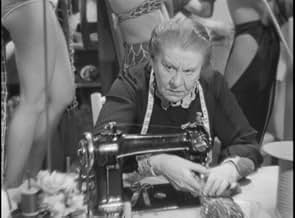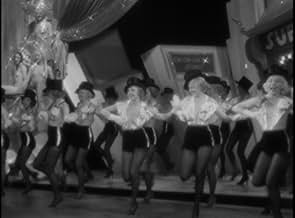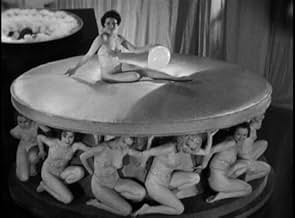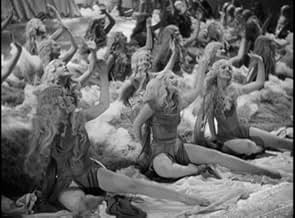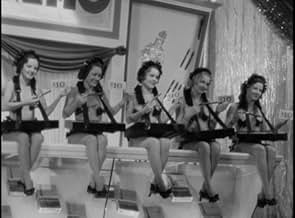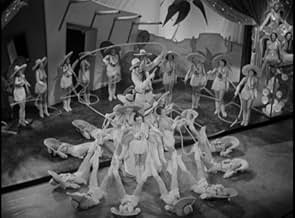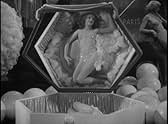AVALIAÇÃO DA IMDb
6,5/10
1 mil
SUA AVALIAÇÃO
Adicionar um enredo no seu idiomaA homicide detective with an eye for the ladies, investigating a murder in Earl Carroll's Vanities, allows the music revue to continue during the investigation.A homicide detective with an eye for the ladies, investigating a murder in Earl Carroll's Vanities, allows the music revue to continue during the investigation.A homicide detective with an eye for the ladies, investigating a murder in Earl Carroll's Vanities, allows the music revue to continue during the investigation.
- Direção
- Roteiristas
- Artistas
- Prêmios
- 1 vitória no total
Charles Middleton
- Homer Boothby
- (as Charles B. Middleton)
Ernestine Anderson
- Earl Carroll Girl
- (não creditado)
Lona Andre
- Lona - Earl Carroll Girl
- (não creditado)
William Arnold
- Treasurer
- (não creditado)
Lucille Ball
- Earl Carroll Girl
- (não creditado)
Lucille Battle
- Black Dancer in Ebony Rhapsody number
- (não creditado)
Avaliações em destaque
Thus sumptuous Paramount art deco musical is almost a definitive pre code extravaganza and is on per with WONDERBAR and FASHIONS OF 1934 and TOP HAT as the glittering perfection of code- cusp risqué showgirl and nightclub sophisticated sexiness. Made at Paramount in late 1933 and clearly designed to outshine the WB Busby Berkeley extravaganzas, this one does it with nude showgirls, drug references, weapons, a slinky killer, murder in the ceiling and dripping blood, and big stage show numbers all crammed over the orchestra pit on the opening night of a big Broadway show. I was reminded of almost every Busby Berkeley film but clearly on a lower budget with the difference being made up by having spectacular costumes. In color this film would be an enduring musical of its time. In gorgeous B&W it still rates but one can see how colorful the costumes are even in monochrome. One startling song SWEET MARIJUANA manages the unparalleled feat of including nudity drugs murder and blood all on screen during the tune. There is a hilarious and nutty island mermaid number and a fantastic and simple art deco staging of COCKTAILS FOR TWO. This film clearly influenced THE GREAT ZIEGFELD made at MGM in 1936.
Murder mystery with a musical backdrop shows its age but has some interesting numbers in particular Duke Ellington's orchestra's production and the now infamous Marijuana number with discreetly covered but unquestionably topless showgirls. Lost in amongst the hundreds of hopeful showgirls and chorus boys are Lucille Ball, Ann Sheridan and Alan Ladd all still years away from any kind of fame and hard to spot. The acting is okay but this is more of a curio as a good example of some of the things that were common before the code, implied or actual nudity, drug references and occasional swearing that would disappear for almost 3 decades when the Hayes code took full effect within a very short time after this film premiered.
This murder mystery with musical numbers is long on atmosphere and character but rather short on suspense and plausibility. Based on a stage play by Broadway showman Earl Carroll and others, it combines a whodunit plot with a backstage ambiance (a homicide investigation takes place on opening night at the theatre where a musical revue is being staged).
The cast is impressive and varied: tough-goofy Victor McLaglen as the police officer who leads the investigation and never fails to leer idiotically at whatever showgirl happens to be in sight; Jack Oakie (the prewar Jack Lemmon – or was Jack Lemmon the postwar Jack Oakie?) as the harassed director who must coordinate the staged performance as well as the chaos behind the scenes; the ever-homely Jessie Ralph as a wardrobe mistress with deep, dark secrets; Dorothy Stickney, who has a stunning close-up monologue near the end, as the tremulous maid madly in love with the male lead; Carl Brisson, the Danish star, as that very male lead, warbling the classic "Cocktails for Two" not once but twice; Kitty Carlisle, operatically delivering "Where Do They Come from and Where Do They Go" and other Johnston-Coslow songs; the glorious Gertrude Michael, who parted from us too soon, as a mean-spirited showgirl whose love for Brisson is spurned; the usually ridiculous Toby Wing who here at least is the center of a laugh-getting running joke.
When the plot complications get out of hand there is always an interesting performer or fun and tuneful musical number to distract the viewer. The film's most celebrated sequence is the "Marahuana" number, led by Michaels, but aside from its controversial history, it's really one of the lesser musical offerings. All of the songs here are staged as if they could actually have fit into a standard proscenium theatre space, as opposed to the cinematic fantasy setup of the Busby Berkeley style.
The cast is impressive and varied: tough-goofy Victor McLaglen as the police officer who leads the investigation and never fails to leer idiotically at whatever showgirl happens to be in sight; Jack Oakie (the prewar Jack Lemmon – or was Jack Lemmon the postwar Jack Oakie?) as the harassed director who must coordinate the staged performance as well as the chaos behind the scenes; the ever-homely Jessie Ralph as a wardrobe mistress with deep, dark secrets; Dorothy Stickney, who has a stunning close-up monologue near the end, as the tremulous maid madly in love with the male lead; Carl Brisson, the Danish star, as that very male lead, warbling the classic "Cocktails for Two" not once but twice; Kitty Carlisle, operatically delivering "Where Do They Come from and Where Do They Go" and other Johnston-Coslow songs; the glorious Gertrude Michael, who parted from us too soon, as a mean-spirited showgirl whose love for Brisson is spurned; the usually ridiculous Toby Wing who here at least is the center of a laugh-getting running joke.
When the plot complications get out of hand there is always an interesting performer or fun and tuneful musical number to distract the viewer. The film's most celebrated sequence is the "Marahuana" number, led by Michaels, but aside from its controversial history, it's really one of the lesser musical offerings. All of the songs here are staged as if they could actually have fit into a standard proscenium theatre space, as opposed to the cinematic fantasy setup of the Busby Berkeley style.
Released just before the Production Code crackdown in July, 1934, Mitch Leisen's all-star Paramount musical is both leeringly suggestive -some even claim misogynistic- and a heck of a lot of fun. Two murders occur on the opening night of "Earl Carroll's Vanities" (one on-stage), but that doesn't stop the manager (Jack Oakie) from putting on a show as a lascivious police detective (Victor McLaglen) investigates. Everyone is hiding something and Gypsy Rose Lee must have seen this backstage murder mystery before she penned "The G-String Murders" as the denouement is similar, albeit more satisfying here. Gertrude Michael, as a vicious diva, stops the show (in more ways than one) with her exotic "Sweet Marijuana" number and Duke Ellington finishes with the truncated "Rape Of The Rhapsody". The hit song, "Cocktails For Two", also came from this bizarre and bawdy camp classic. Here's Louella O. Parsons in the "Los Angeles Examiner" on May 17, 1934:
Earl Carroll's hand-picked beauties' pirouette about on the Grauman United Artists screen in a fig leaf and not much else. But September Morn herself never had a better figure than these charmers, who are made up to please the eye, especially the eye of the tired businessman. But don't for a moment think Mr. Carroll's girls, au naturelle, are the only attraction. Believe it or not, MURDER AT THE VANITIES is a musical comedy thriller, if you know what I mean -a murder mystery incorporated in a musical show. It all happens on the opening night at the time the play is in progress and a search is on for a murderer. Just by way of suspense, a cop threatens to stop the show every few minutes. Victor McLaglen is something new in cops. All the time he is trying to track down the murderer, he keeps his eye fastened on the chorus beauties. The murder mystery is good with the exception of the denouement, which is pretty flat. Probably faulty direction. Dorothy Stickney, who plays the maid, is about as melodramatic as the heroine in a ten, twenty, and thirty show. For no good reason, she rates a never-ending closeup in the big dramatic scene. The girl ensembles are good, and it's a positive relief to get away from the inevitable overhead shots. The costumes are beautiful; in fact, this is a musical that Paramount can feel is really to their credit. As for Carl Brisson -well, he would be an addition to any show. Good-looking with a delightful singing voice and an easy, assured manner, he is all his press agents claim for him. I also like Kitty Carlisle, who plays the leading lady in the show. Gertrude Michael, as the deep-eyed villainess, gives an interesting if rather fictional portrayal. Jack Oakie, as the stage manager, is the same old wisecracking Jack, but we wouldn't change him. Jessie Ralph is excellent as the seamstress. Others in the cast are Charles Middleton, Gail Patrick, Donald Meek, Barbara Fritchie, Toby Wing and Lona Andre. The screen play is by Carey Wilson and Rufus King, and the direction by Mitchell Leisen. The music is by Arthur Johnstone and the lyrics by Sam Coslow. In addition to MURDER AT THE VANITIES, there is a Mickey Mouse cartoon, a Paramount Newsreel, and a two-reeler, THE WRONG DIRECTION.
I disagree with Lolly on the denouement, it's satisfying if over-the-top. Why would she blame the director? Was she displeased with the story's ending -or the way it was staged? And what's a "ten, twenty, or thirty show"? Note the swipe taken at Busby Berkeley and his "overhead shots". As hard as it may be to believe today, the public was tiring of Buzz' schtick by May, 1934. Mitch Leisen said, "if you are showing a stage show that's supposed to be in a theater, you should stay within the bounds of the proscenium arch, and not do a Buzz Berkeley routine with a stage set that's acres big."
Q: Don't you think Berkeley's spectacular effects justified taking this liberty? ML: Apparently they did because they're reviving all of his pictures and none of mine, but personally I don't like it.
Earl Carroll's hand-picked beauties' pirouette about on the Grauman United Artists screen in a fig leaf and not much else. But September Morn herself never had a better figure than these charmers, who are made up to please the eye, especially the eye of the tired businessman. But don't for a moment think Mr. Carroll's girls, au naturelle, are the only attraction. Believe it or not, MURDER AT THE VANITIES is a musical comedy thriller, if you know what I mean -a murder mystery incorporated in a musical show. It all happens on the opening night at the time the play is in progress and a search is on for a murderer. Just by way of suspense, a cop threatens to stop the show every few minutes. Victor McLaglen is something new in cops. All the time he is trying to track down the murderer, he keeps his eye fastened on the chorus beauties. The murder mystery is good with the exception of the denouement, which is pretty flat. Probably faulty direction. Dorothy Stickney, who plays the maid, is about as melodramatic as the heroine in a ten, twenty, and thirty show. For no good reason, she rates a never-ending closeup in the big dramatic scene. The girl ensembles are good, and it's a positive relief to get away from the inevitable overhead shots. The costumes are beautiful; in fact, this is a musical that Paramount can feel is really to their credit. As for Carl Brisson -well, he would be an addition to any show. Good-looking with a delightful singing voice and an easy, assured manner, he is all his press agents claim for him. I also like Kitty Carlisle, who plays the leading lady in the show. Gertrude Michael, as the deep-eyed villainess, gives an interesting if rather fictional portrayal. Jack Oakie, as the stage manager, is the same old wisecracking Jack, but we wouldn't change him. Jessie Ralph is excellent as the seamstress. Others in the cast are Charles Middleton, Gail Patrick, Donald Meek, Barbara Fritchie, Toby Wing and Lona Andre. The screen play is by Carey Wilson and Rufus King, and the direction by Mitchell Leisen. The music is by Arthur Johnstone and the lyrics by Sam Coslow. In addition to MURDER AT THE VANITIES, there is a Mickey Mouse cartoon, a Paramount Newsreel, and a two-reeler, THE WRONG DIRECTION.
I disagree with Lolly on the denouement, it's satisfying if over-the-top. Why would she blame the director? Was she displeased with the story's ending -or the way it was staged? And what's a "ten, twenty, or thirty show"? Note the swipe taken at Busby Berkeley and his "overhead shots". As hard as it may be to believe today, the public was tiring of Buzz' schtick by May, 1934. Mitch Leisen said, "if you are showing a stage show that's supposed to be in a theater, you should stay within the bounds of the proscenium arch, and not do a Buzz Berkeley routine with a stage set that's acres big."
Q: Don't you think Berkeley's spectacular effects justified taking this liberty? ML: Apparently they did because they're reviving all of his pictures and none of mine, but personally I don't like it.
A fast-paced murder mystery set backstage at a performance of Earl Carroll's Vanities.
It's clear the filmmakers' primary motivation was to showcase the Vanities and realized they needed to wrap a movie around it. Far more screen time is given to the lavish musical numbers featuring countless scantily clad women than to the mechanics of the nominal plot, but that's not a criticism. It's rather fascinating to see this unique brand of stage entertainment captured in all its antiquated glory, and honestly the women are more interesting to watch than the story anyway. And though this is mostly a disposable B movie, it really does come alive in a special way during some of the musical moments, and some of the magic of seeing this kind of show performed live is captured on screen.
The cast includes an appealing Kitty Carlisle and a humorous Victor McLaglen, right before he was to win an Oscar for John Ford's "The Informer." Duke Ellington also makes a cameo.
Pretty fun stuff.
Grade: B+
It's clear the filmmakers' primary motivation was to showcase the Vanities and realized they needed to wrap a movie around it. Far more screen time is given to the lavish musical numbers featuring countless scantily clad women than to the mechanics of the nominal plot, but that's not a criticism. It's rather fascinating to see this unique brand of stage entertainment captured in all its antiquated glory, and honestly the women are more interesting to watch than the story anyway. And though this is mostly a disposable B movie, it really does come alive in a special way during some of the musical moments, and some of the magic of seeing this kind of show performed live is captured on screen.
The cast includes an appealing Kitty Carlisle and a humorous Victor McLaglen, right before he was to win an Oscar for John Ford's "The Informer." Duke Ellington also makes a cameo.
Pretty fun stuff.
Grade: B+
Você sabia?
- CuriosidadesMany of the Earl Carroll Girls featured in the film were authentic cast members from Carroll's stage show, which ran from September 12th to November, 1933, at the New Amsterdam Theatre, and at the Majestic Theatre from November 6th, 1933 to March 10th, 1934. These cast members were brought out to Hollywood from New York especially for this film, and many stayed to pursue film careers.
- Erros de gravaçãoWhen the body of the woman on the catwalk is turned on her back, you can see the actress' chest rise and fall as she takes a breath.
- Citações
[last lines]
Jack Ellery: Nancy, what shall I do?
Nancy: Oh, Mr. Ellery!
Jack Ellery: C'mon, let's do it.
- ConexõesEdited into Ondas Sonoras de 1937 (1936)
- Trilhas sonorasEbony Rhapsody
(uncredited)
by Arthur Johnston and Sam Coslow
Sung by Carl Brisson, Kitty Carlisle and Gertrude Michael
Principais escolhas
Faça login para avaliar e ver a lista de recomendações personalizadas
- How long is Murder at the Vanities?Fornecido pela Alexa
Detalhes
- Data de lançamento
- País de origem
- Idioma
- Também conhecido como
- Murder at the Vanities
- Locações de filme
- Empresa de produção
- Consulte mais créditos da empresa na IMDbPro
- Tempo de duração1 hora 29 minutos
- Cor
- Proporção
- 1.37 : 1
Contribua para esta página
Sugerir uma alteração ou adicionar conteúdo ausente

Principal brecha
By what name was Segue o Espetáculo (1934) officially released in India in English?
Responda

